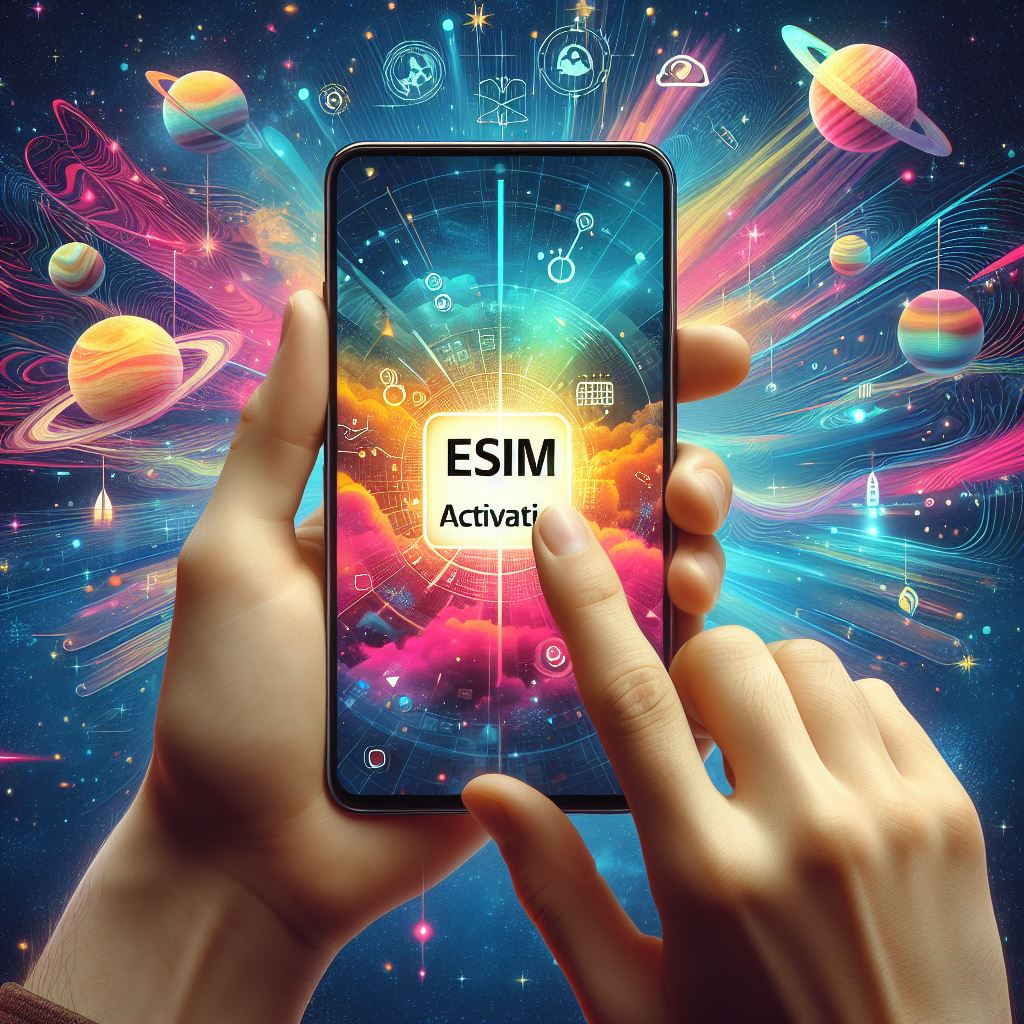eSIM Usage Frequency
Published by
Jan 17 2024

Understanding eSIM Usage Frequency: A Comprehensive Guide

Stay in control of your connectivity. Our guide delves into the significance of tracking eSIM usage frequency for enhanced mobile experiences.
As eSIM technology continues to gain popularity, it is essential to understand the usage frequency and the various aspects associated with it. One of the primary advantages of eSIM over traditional physical SIM cards is the flexibility it offers. With a physical SIM card, users are often limited to a single network, requiring the hassle of switching SIM cards when traveling or changing service providers.
In contrast, eSIM technology allows users to switch between different networks seamlessly, without the need for a physical SIM. This not only saves time but also eliminates the risk of misplacing or damaging the physical SIM card. By understanding the eSIM usage frequency, users can fully leverage the potential of this innovative technology and experience enhanced connectivity on their mobile phones.
The Evolution of SIM Cards: From Physical SIM to eSIM Technology
The emergence of eSIM technology marks a significant milestone in the evolution of SIM cards. Traditionally, mobile networks used physical SIM cards to enable communication services for users. These SIM cards, which stored mobile data and subscriber information, needed to be physically inserted into mobile devices. However, with the advent of eSIMs, the process of activating mobile network services has become more streamlined and convenient.
Unlike traditional SIM cards, eSIMs are embedded directly into mobile devices, eliminating the need for physical cards. This innovation enables users to activate their mobile network services remotely, using a process known as remote SIM provisioning. Mobile network operators play a crucial role in this process, as they are responsible for activating the eSIM and configuring the necessary mobile data settings. Through remote SIM provisioning, users can seamlessly switch between multiple mobile networks, enhancing flexibility and convenience. This evolution in SIM card technology has paved the way for a more connected world, where users can easily manage their mobile numbers and maximize the benefits of eSIMs.
How eSIMs Work: Exploring the Subscriber Identity Module

Interactive connectivity at your fingertips.
The Subscriber Identity Module, commonly known as SIM, is an essential component in mobile communication. Traditionally, wireless providers issued plastic SIM cards that stored user information, such as phone numbers and network credentials. With the introduction of eSIM technology, the need for physical cards is eliminated. Instead of physically inserting a SIM card into a device, an eSIM device is integrated directly into the device’s hardware. This allows for seamless switching between multiple networks, making it particularly convenient for users with dual SIM phones or those who frequently travel between different countries.
To be eSIM compatible, a device requires the necessary hardware and software support. Once activated, the user can add multiple network profiles to their eSIM device, allowing them to easily switch networks without the need for physical SIM card swaps. The process of switching networks is simplified, as it can be done remotely, eliminating the need for physical SIM card replacements. By having multiple profiles saved on their eSIM, users can choose the network they wish to connect to, depending on their location and service availability. Whether it’s connecting to a local network while traveling or switching between networks for better coverage, the eSIM offers flexibility and convenience to mobile phone users.
The Benefits of eSIMs for Mobile Phone Users
The advent of eSIM technology has brought about a multitude of benefits for mobile phone users. One of the most significant advantages is the elimination of traditional SIM cards. In the past, users had to rely on physical, removable SIM cards to connect to a cellular network. With eSIMs, however, all the necessary information is embedded directly into the cellular device itself. This means that users no longer need to worry about misplacing or damaging their SIM cards, resulting in a more convenient and reliable experience.
For Apple users eSIMs provide an added layer of flexibility. For example, iPhone XS and iPhone XS Max are equipped with both a traditional physical SIM card slot and an embedded eSIM, giving users the option to connect to multiple networks simultaneously. This dual SIM capability enables users to easily switch between different plans or carriers without the need for multiple devices. Additionally, eSIMs allow for seamless connectivity in areas with Wi-Fi but limited cellular coverage, as users can easily switch to Wi-Fi calling without any interruptions.
The Role of Mobile Network Operators in eSIM Activation

Mobile network operators play a crucial role in the activation of eSIMs on mobile devices. With the advent of eSIM technology, users can now have multiple SIM cards on the same device without the need for physical SIM cards. This eliminates the hassle of switching SIM cards or carrying multiple phones.
To activate an eSIM, users need to contact their mobile network operator and provide the necessary information. The operator will then send a QR code to the user, which can be scanned through the phone settings to activate the eSIM profile. This allows users to have more than one SIM card on their device, enabling them to easily switch between different networks or have separate numbers for personal and professional use. With the convenience of dual SIM functionality through eSIMs, users can enjoy flexibility and seamless connectivity without the limitations of physical SIM cards.
Exploring Remote SIM Provisioning: Simplifying the eSIM Activation Process
Remote SIM provisioning is a crucial aspect of simplifying the eSIM activation process. With the advancement in technology, the traditional physical SIM cards are gradually being replaced by their digital counterpart, the eSIM. The term eSIM refers to an embedded SIM that is built directly into a device, eliminating the need for a physical SIM card. This digital SIM can be programmed with multiple eSIM profiles, allowing users to switch between different mobile numbers and plans seamlessly.
The convenience of remote SIM provisioning lies in its ability to enable users to activate an eSIM without the need to physically insert a SIM card into their device. This streamlines the activation process and makes it more user-friendly. Users can now easily set up their eSIM profiles, define their mobile numbers, and manage their connectivity options in one place. By simplifying the activation process, remote SIM provisioning paves the way for a more convenient and efficient digital experience, both in our personal and professional lives.
Furthermore, remote SIM provisioning is an essential component of the broader eSIM ecosystem that encompasses mobile network operators, device manufacturers, and software providers, all working together to deliver a seamless and integrated user experience.
eSIM vs. Traditional SIM Cards: Which is Right for You?

In your hands, the power to choose.
eSIMs and traditional SIM cards both serve the same function of providing mobile communication capabilities to devices. However, there are certain factors to consider when deciding which option is right for you.
One of the key benefits of eSIMs is their ability to support multiple profiles on a single device. This means that with an eSIM, you can have multiple mobile numbers and switch between them without physically changing SIM cards. This is particularly convenient for individuals who travel frequently or need separate numbers for work and personal use. For example, the iPhone XR is an eSIM-enabled device, allowing users to easily switch between carriers and take advantage of different plans or offers.
On the other hand, traditional SIM cards are still widely used, especially in older devices that may not have eSIM capabilities. If you have an older phone that doesn’t support eSIM, or if you don’t need the flexibility of multiple profiles, a traditional SIM card may be a more suitable option. Additionally, some individuals prefer the tangible nature of a physical SIM card and the ability to easily swap it between devices.
Ultimately, the choice between an eSIM and a traditional SIM card depends on your specific needs and preferences. If you require multiple profiles or have an eSIM-enabled device, an eSIM may offer more convenience and flexibility. However, if you have an older device or prefer the simplicity of a physical SIM card, sticking to the traditional option may be the better choice.
Dual SIM Phones and the Convenience of Multiple Networks
Dual SIM phones have become increasingly popular in recent years due to their convenience in allowing users to instantly connect to multiple networks. With the use of eSIM technology, these phones can support multiple SIM profiles, each with its own mobile number. This eliminates the need for carrying multiple physical SIM cards, simplifying the process of managing phone numbers and network connections.
One of the major advantages of dual SIM phones is the flexibility they offer to users. Instead of being limited to a single network, users can choose to have multiple eSIMs on their device, allowing them to switch between different networks as needed. This can be particularly useful for individuals who travel frequently or for business professionals who require separate phone numbers for work and personal use. Furthermore, dual SIM phones often come with features that allow the user to easily manage and prioritize the usage of the different phone numbers on their device.
As the demand for more versatile smartphones continues to grow, original equipment manufacturers (OEMs) are recognizing the value of incorporating dual SIM functionality into their devices. This has led to an increase in the number of eSIM-compatible phones available in the market, with various options to suit different user preferences. Whether it’s having the ability to use two different network providers simultaneously or simply having the convenience of managing multiple phone numbers on one device, dual SIM phones are revolutionizing the way we stay connected.
The Role of eSIM in the Rise of Connected Devices

eSIMs are at the core of smartwatches, tablets, and IoT devices, driving the rise of interconnected technology.
With the rapid advancement of technology, the rise of connected devices has become increasingly prominent. The role of eSIM in this evolution is undeniable. Unlike traditional plastic SIM cards, eSIMs offer a more streamlined and convenient activation method for users. With eSIMs, there is no need for physical swapping or the limitation of having multiple devices with separate data plans. Instead, eSIMs allow end users to seamlessly switch between devices and connect to global systems, enabling a truly connected experience.
As more and more devices become interconnected, the demand for efficient and hassle-free connectivity is greater than ever. This is where eSIMs prove their worth. With the ability to store multiple profiles on a single eSIM, users can easily manage their connectivity needs across various devices. The process of activating eSIMs is also simplified, with the option to remotely provision the subscriber identity module. This empowers end users to activate their eSIMs and connect to networks without the need for physical interaction, making it an ideal solution for the growing number of connected devices in our daily lives.
eSIM Profiles and Managing Multiple Mobile Numbers
To simplify the management of multiple mobile numbers, eSIM profiles offer a convenient solution. With eSIM technology, users can easily switch between different carriers without the need to physically swap out SIM cards. Instead, they can simply download the desired eSIM profile onto their device. This enables them to utilize different mobile numbers from various carriers on the same device.
One notable advantage of eSIM profiles is the ability to receive text messages from multiple mobile numbers on a single device. This is particularly useful for individuals who have different phone numbers for work and personal use. By having separate eSIM profiles for each number, users can keep their communications organized and easily distinguish between the various contacts and conversations.
Device manufacturers, such as Apple, have embraced eSIM technology and provide built-in eSIM management tools within their devices. Through the device settings, users can conveniently activate, deactivate, and switch between eSIM profiles. This eliminates the need to visit physical stores or contact customer service when changing carriers or managing different mobile numbers. By linking eSIM profiles to their Apple ID, users can seamlessly transition between carriers and benefit from the versatility offered by eSIM technology.
Activating eSIMs: A Step-by-Step Guide

Activation made easy.
Activating eSIMs on your phone is a simple process that can be done right from the comfort of your own home screen. The first step is to ensure that your phone is eSIM capable. Many newer smartphone models support eSIM technology, but it’s always a good idea to check the specifications or consult with your phone’s manufacturer to confirm. Once you have verified that your phone supports eSIM, the next step is to obtain an eSIM. This can usually be done through your mobile network operator or through an eSIM provider. With the eSIM in hand, you’re ready to activate it on your phone and start enjoying the benefits.
One of the key advantages of using eSIMs is the flexibility it offers to switch between different mobile network operators and stay connected wherever you go. By activating an eSIM, you can easily switch between multiple network profiles, enabling you to choose the best network coverage or take advantage of cost-saving opportunities. Additionally, eSIMs open up new revenue streams for mobile network operators as they can offer data plans to eSIM users without the need for physical SIM cards. This not only benefits consumers by providing more options, but it also promotes healthy competition and innovation in the telecommunications industry. So, whether you’re a frequent traveler, a business professional, or simply someone who wants to simplify their mobile experience, activating an eSIM is a step towards a more connected future.
Unlocking the Potential of eSIMs: Understanding the Ecosystem
With the rapid advancement of technology, the potential of eSIMs to revolutionize the way we connect and communicate is becoming increasingly evident. The eSIM ecosystem encompasses a vast network of devices, mobile network operators, and manufacturers, all working in harmony to unlock the full potential of this innovative technology.
eSIM makes it possible for devices to connect to different networks without the need for physical SIM cards. This not only streamlines the process of switching networks, but also opens up a multitude of possibilities for users. With an eSIM, users can easily switch between networks, take advantage of local data plans when traveling, and even manage multiple mobile numbers on a single device. The ecosystem surrounding eSIM technology ensures that these benefits are accessible to users, providing a seamless and efficient experience.
eSIM Usage Frequency: Maximizing the Benefits for End Users

Empower your connectivity journey.
eSIM usage frequency plays a crucial role in maximizing the benefits for end users. With an eSIM, mobile phone users have the flexibility to switch between different mobile networks seamlessly, facilitating uninterrupted connectivity. This is particularly advantageous for frequent travelers or individuals who rely on multiple networks for different purposes, such as personal and work-related activities.
One key benefit of eSIMs is the ability to easily manage multiple mobile numbers on a single device. This eliminates the need for carrying multiple physical SIM cards or using dual SIM phones, simplifying the user experience. By utilizing different eSIM profiles, users can assign specific numbers to different purposes, enabling efficient communication management. For example, professionals can dedicate one eSIM profile for work-related calls and messages, while reserving another for personal use. This level of control and customization ensures that users can tailor their mobile experience according to their specific needs and preferences.
FAQs on eSIM Usage Frequency
What is an eSIM?
An eSIM, short for embedded SIM, is a technology that allows mobile devices to have a virtual SIM card instead of a physical one. It is built directly into the device and can be programmed with multiple mobile network profiles.
How does an eSIM work?
An eSIM works by storing the subscriber’s profile and associated network information directly on the device. It eliminates the need for a physical SIM card and enables users to switch between different mobile networks without changing the SIM card.
What are the benefits of using an eSIM?
The benefits of using an eSIM include the ability to switch between mobile networks without changing SIM cards, simplified activation process, support for multiple mobile numbers on a single device, and compatibility with various connected devices.
What is the difference between an eSIM and a traditional SIM card?
The main difference between an eSIM and a traditional SIM card is that the eSIM is embedded directly into the device, while a traditional SIM card is a physical card that needs to be inserted into the device. eSIMs also allow for easier network switching and support for multiple mobile numbers.
Can I use eSIM on any mobile device?
Not all mobile devices support eSIM technology. However, an increasing number of smartphones, tablets, and wearable devices are now compatible with eSIMs. It is important to check the device specifications to see if it supports eSIM functionality.
How do I activate an eSIM?
The activation process for an eSIM varies depending on the mobile network operator and the device. It usually involves scanning a QR code provided by the operator or manually entering an activation code. Detailed step-by-step guides are often provided by the mobile network operator.
Can I use multiple mobile numbers on a device with an eSIM?
Yes, one of the advantages of eSIM technology is the ability to have multiple mobile numbers on a single device. This is particularly useful for individuals who want to use separate numbers for personal and business purposes or when traveling abroad.
Can I switch mobile networks easily with an eSIM?
Yes, switching mobile networks with an eSIM is much easier compared to traditional SIM cards. Users can simply choose the desired network profile on their device settings, eliminating the need to physically replace the SIM card.
Is it possible to use eSIMs with dual SIM phones?
Yes, many dual SIM phones now support eSIM technology. This means that users can have two physical SIM cards along with an eSIM, allowing for even more flexibility and convenience when it comes to managing multiple mobile numbers and networks.
What is remote SIM provisioning?
Remote SIM provisioning, also known as RSP, is a process that enables the activation and management of eSIMs over-the-air. It simplifies the activation process and eliminates the need for physical SIM cards, making it more convenient for end users.
Are eSIMs only used in smartphones?
No, eSIMs are not limited to smartphones. They are increasingly being used in various connected devices such as tablets, smartwatches, IoT devices, and even cars. This allows these devices to have cellular connectivity without the need for physical SIM cards.

